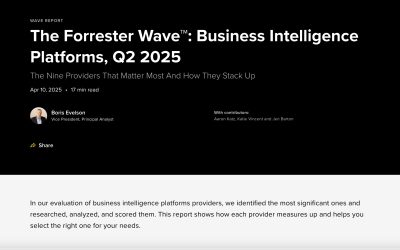BI dashboards: The key to transparency and efficiency in business operations
Businesses rely on data to make informed decisions about their operations. However, sifting through mountains of data can be time-consuming and overwhelming. This is where BI dashboards come in.
Dashboards provide a quick and easy way to visualize data, identify trends, and track KPIs. They help businesses make data-driven decisions by providing transparency into their operations.
So why are so many businesses not using dashboards? Some dashboard tools can seem too complex or expensive for small businesses. Many business owners fear that they won’t be able to make sense of the data. Others simply don’t know where to start.
Yet the risks of not using dashboards far outweigh the costs. Dashboards can save businesses time and money by helping them avoid making costly mistakes. And if used correctly, dashboards can be an invaluable tool for making data-driven decisions.
Creating an effective dashboard doesn’t have to be complicated or expensive. In this article, we will guide you through the concept of BI dashboard creation—and why dashboard sharing is the key to success.
How BI dashboards have impacted businesses
In today’s business world, data is everything. Companies rely on data to make informed decisions about everything from where to open new stores to which products to stock on their shelves.
But with so much data available, it can be challenging to know where to start. BI dashboards are designed to help businesses quickly and easily understand their data. They can be built and used to track everything from sales figures to customer satisfaction levels.
Best of all, they can be shared across an organization, making it easy for everyone to stay on the same page.
Dashboards have become essential tools for businesses of all sizes, and their impact cannot be overstated. From small businesses to Fortune 500 companies, dashboards are being used to make data-driven decisions that improve efficiency and drive growth.

BI dashboards: Increasing transparency and efficiency
The benefits of using BI dashboards are numerous, but two of the most important are transparency and efficiency.
Transparency
In order for businesses to make data-driven decisions, they need to be able to understand their data. However, this can be difficult when there is so much data to sift through.
Dashboards provide transparency by giving businesses a clear view of their most important KPIs. This allows businesses to quickly identify trends and make informed decisions about their operations.
Plus, in a world that increasingly places a premium on data privacy, dashboards offer a secure way for businesses to share data within their organization. By using dashboard sharing, businesses can give their employees access to the data they need without sacrificing security.
For example, let’s say you’re a retailer who wants to track customer satisfaction levels. You could create a dashboard that includes data on things like return rates, customer complaints, and social media sentiment. This would give you a clear view of how your customers feel about your store and help you make decisions accordingly.
Once you have transparency in your data, you can start to make changes that will improve your business.
Efficiency
In addition to transparency, dashboards also offer businesses a way to improve their efficiency. This is one of the most critical aspects of dashboard sharing.
By giving employees access to dashboards, businesses can enjoy several unique benefits.
1. Employees can quickly find the data they need
There’s no need to waste time sifting through mountains of data. With dashboard sharing, businesses can give their employees direct access to the data they need. This allows them to quickly find the information they’re looking for and make decisions accordingly.
By removing obstacles like data silos, businesses can encourage their employees to be more efficient in their work.
2. Businesses can save money on training
Another benefit of dashboard sharing is that businesses can save money on training. When employees have direct access to dashboards, they can learn how to use them on their own. This eliminates the need for expensive training programs. Plus, it allows businesses to get the most out of their dashboard investment.
3. Employees can work from anywhere
With dashboard sharing, businesses can allow their employees to work from anywhere. This is especially beneficial for businesses with remote employees. By giving employees access to dashboards, businesses can encourage collaboration without sacrificing flexibility.

How to create an effective BI dashboard for your team
Now that you know the benefits of dashboard sharing, it’s time to learn how to create an effective dashboard. These tips will help you get started:
1. Define your goals
The first step in creating an effective dashboard is to define your goals. Ask yourself–and your team–what you want to accomplish with your dashboard. This will help you determine which KPIs to track and how to present your data.
2. Utilize a powerful BI tool
There are a number of business intelligence tools on the market, but not all of them are equal. When choosing a BI tool for your dashboard, make sure to select one that is powerful and easy to use. This will ensure that you can create an effective dashboard without any headaches.
3. Don’t complicate things
When creating your dashboard, it’s important to keep things simple. Your dashboard should be easy to understand and use. Otherwise, you run the risk of confusing or frustrating your team.
Remember—the goal is to improve efficiency, not complicate things further. So, when in doubt, keep it simple.
4. Get feedback
After you’ve created your dashboard, getting feedback from your team is important. Ask them how they like the dashboard and if there are any improvements that could be made. This will help you fine-tune your dashboard and ensure that it meets the needs of your team.
5. Make changes as needed
As your business changes, so too should your dashboard. Make sure to regularly review your dashboard and make changes as needed. This will ensure that your dashboard always provides the most value to your team.
Practical tips for personalized dashboard sharing
No matter the department or the data, these tips for dashboard sharing will help you get started:
1. Define dashboard roles and access levels
The first step is to define who should have access to your dashboard—and at what level. This will ensure that only the appropriate people have access to sensitive data. For instance, you may want to give managers full access to all dashboard data while giving employees read-only access.
2. Set up alerts and notifications
Next, you’ll want to set up alerts and notifications for your dashboard. This way, you can be notified immediately if there is a metric that changes significantly. An example of an alert would be if a KPI falls below a certain threshold.
3. Create dashboard templates
Creating dashboard templates can save you a lot of time in the long run. With dashboard templates, you can easily create new dashboards without starting from scratch. This is especially helpful if you regularly need to create similar dashboards for different departments or projects.
4. Use data visualization
Data visualization is a powerful way to convey information. When used correctly, it can make your dashboard more engaging and easier to understand. This is especially helpful if you’re dealing with large amounts of data.
5. Keep it user-friendly
Remember, the goal is to make your dashboard as user-friendly as possible. Use clear and concise language and avoid jargon. Also, be sure to test your dashboard before sharing it with others. This will help you catch any errors or problems that need to be fixed.
The bottom line
Dashboard sharing can help businesses improve transparency and efficiency in their operations. By defining dashboard roles and access levels, setting up alerts and notifications, and using data visualization, businesses can create effective dashboards that meet the needs of their team.
Check out some related resources:

Guide to Data Pipeline Design: Steps and Patterns

Cloud Data Warehouse Usage Surges 116% as Industries Race to the Cloud






